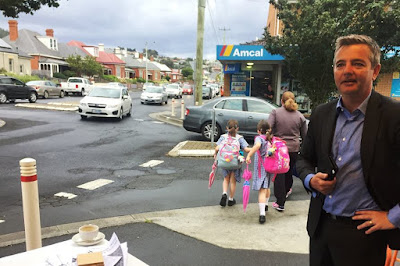All the visitors were amazed by the volume of traffic and its speed. Standing outside the butcher's on the corner of Hamilton Street, we could even see the stream of vehicles coming from Mt Stuart and heading in our direction. Some near misses were observed around the Hill St Grocer, and there was an actual collision outside the Post Office at the other end of Lansdowne Crescent.
Here are the key numbers showing the activity on Hill St between 8am and 9am:
Line across Hill St from the Pharmacy, corner Pine St
|
Line across Hill St from the P.O., corner Patrick St
|
Line across Hill St from the Butcher, corner Hamilton St
|
|
Total vehicles passing the “laser line”
|
1172
(includes 10 bike commuters)
|
1284 *
(includes 1 bike commuter, who had
resorted to the footpath)**
|
|
Adult pedestrians crossing Hill St
|
47
|
54
|
23
|
Child pedestrians crossing Hill St
|
36
|
63
|
15
(all were accompanied by a parent)
|
Total pedestrians crossing Hill St
|
83
|
117
|
38
|
*A collision occurred at 8.50am, causing a blockage and a
number of vehicles turned around to avoid the delay.
** Bike commuters heading to the city would cut through via
Bonnington Rd or Forbes Ave to get off the rat run and down to Goulburn St.
These numbers of vehicles and pedestrians more than satisfy the minimum requirement accepted by the Department of State Growth for installation of a proper Pedestrian Crossing (i.e. zebra crossing), which the community has been asking the Council for for some time.
Think about these numbers! With 1200 vehicles per hour streaming down Hill St in the peak hour/s, and many of the drivers trying to attain the stated speed limit of 50 kph, it is difficult and nervewracking for fit and able people to cross the street. It is downright scary for anyone under the age of 12 or over the age of 70 or with limited vision, cognitive ability or movement.
As it is largely a steady stream, 1200 vehicles per hour means 20 vehicles per minute, means a vehicle every 3 seconds. That means the pedestrian has an average of 3 seconds to scamper to the median strip, and 3 seconds to scamper to the opposite footpath.
So naturally we didn't see any young children walking to school on their own, they were all accompanied by a parent (walking or riding) or were passengers in vehicles (adding to the congestion).
Many of the pedestrians trying to cross Hill Street yesterday morning, or simply passing by, took the opportunity to ask our visiting Aldermen or Members of Parliament what they were going to do about making it safer to cross the street.
WHEN believes that a key to making our streets safer is speed. Lower speeds reduce the tension on the street, encourage better driver behaviour (such as courtesy!), help pedestrians and bike riders to use the street with more confidence, and reduce the risk of injury or death should a collision occur.
Council is about to consider recommendations from its traffic engineering team on safer crossings on Hill Street. WHEN's preferred solution has been stated on many occasions, but we are not holding our breath for this. We expect that the proposed engineering interventions will, at the very least, act to reduce average speeds on Hill Street and not increase risk for bike riders.Want to see how long we have been raising these issues? Check out previous posts in the WHEN blog:
Outcomes of the community workshop Nov 2016
Update August 2016
Update April 2016
And older posts...
 |
| Counting vehicles and pedestrians, cnr Patrick St |
 |
| Counting pedestrians, cnr Hamilton St |
 |
| Counting vehicles & pedestrians, cnr Pine St |